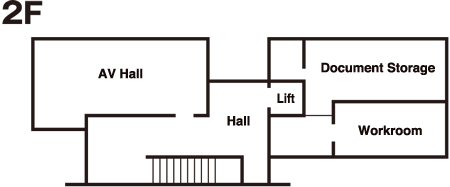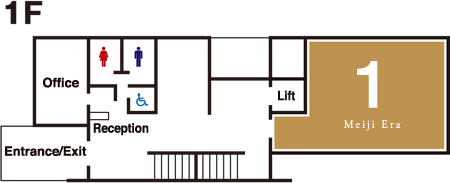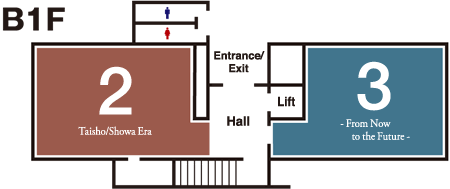- Home
- About the Museum
About the Museum
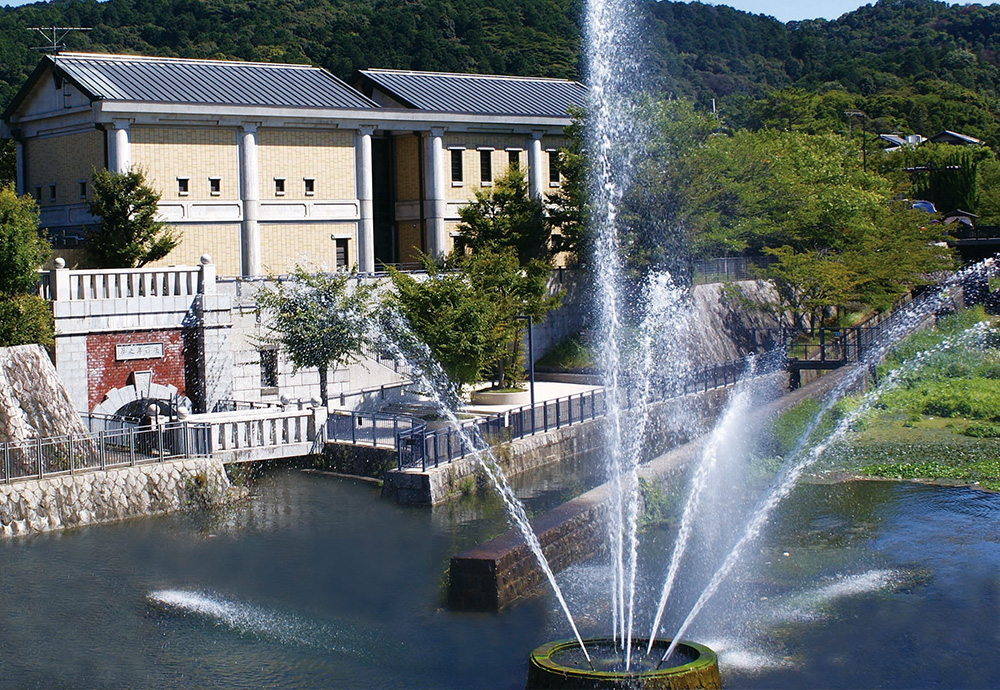

Lake Biwa Canal. The What, Who, When, Where and Why.
The Lake Biwa Canal Museum surely holds the answers to the many questions you will have.
You can enjoy our carefully constructed miniatures including one of the Keage Incline, showing the specially designed trolley with a boat loaded onto it being hauled up the slope. Or a diorama of the Keage and Okazaki area, and a viewing corner for our large and precious archived footage collection.
On the outdoor terrace, a wonderful view of Okazaki Canal and the water fountain is waiting for you. Make sure you drop by when you visit Nanzenji Suirokaku or Keage Incline.
Exhibits/Materials
1F

Entrance
As well as tunnel arches from the Lake Biwa Canal and lighting that takes its inspiration from the rippling of the water in the canal, you can also find panels that introduce notable places along the canal.

Theater
The theater shows a movie that explains the passion of and difficulties faced by the people involved in the construction of the Lake Biwa Canal in an easy to understand way, and shows viewers the wonderful sights that can be seen along the canal.

First GalleryVoice guidance
The third Prefectural Governor of Kyoto Kitagaki Kunimichi planned the Lake Biwa Canal as a great project to revitalize the city of Kyoto. The canal was then brought to fruition by the engineers Minami Ichirobe and Tanabe Sakuro. Exhibition Room 1 explains how the Lake Biwa Canal was planned and constructed.
On display are valuable documents including precision survey diagrams.

Projection mapping gives you a sense of how canal construction proceeded and its scale.
B1F

Second GalleryVoice guidance
Canal No. 1, which was completed in 1890, fulfilled a number of roles including hydroelectric power generation and water transport. With the completion of the Three Great Works in 1912, Kyoto was transformed into a modern city. Exhibition Room 2 explains how the people of Kyoto used water from the Lake Biwa Canal to develop the city.
1A model of the area around Okazaki in 1915.
2An introduction to the people who strove to bring the plan for the Lake Biwa Canal to fruition.

Third GalleryVoice guidance
The role that water from the Lake Biwa Canal plays has changed greatly with the times. Water transportation died out with the development of railways and automobiles, and watermills disappeared as agricultural land turned into residential land with the increasing population. However, water from Lake Biwa Canal continues to support life in Kyoto by providing, among other things, a water source for the water supply as well as generating electricity. Enjoy learning the story of the canal from turbulent past times to the present and into the future.
2F

On the second floor, LEGO bricks reproducing canal-related facilities are on display, and visitors can enjoy a wonderful view of the fountain and canal through the glass.

Outdoors(1F & B1F)

You can enjoy coffee and light meals inside the restaurant as well as outside on the terrace while viewing the canal and fountain (open seasonally, mainly in spring and fall).*Opening hours: 10:00 a.m. - 4:00 p.m.

Outside the museum, 45-degree iron tubes used in the Gosho Water Supply System are exhibited on the outside of the first floor. The Pelton waterwheel and Stanley generator used for hydraulic power generation utilizing Lake Biwa Canal are exhibited on the outside of the first basement floor.

Enjoy an up-close view of the drum plant which made use of the Keage Incline.
(Viewing is available until 4 p.m.)
Using virtual reality technology, it is possible to view the drum plant back in a time when the Keage Ink Railway Line was still in operation.
https://www.biwakososui-vr.com/3dcgvr/jp/vr/drum.html

It's possible to view the fountain from the underground square.
Water used to supply the fountain is canal water transported from the upstream Keage Boat Basin via a pipe.
No electric power is used to pump the water; rather, the roughly 36-meter (118-foot) elevation difference is utilized for an inverse-siphon effect that naturally transports the water uphill within the pipe.
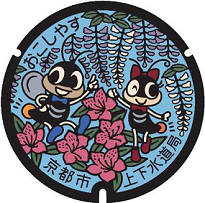
The designs of certain manhole covers feature Sumito and Hikari, which are mascot characters for the Kyoto City Water Supply and Sewerage Bureau.
This design depicts the azaleas at the Keage Water Filtration Plant and the wisteria flowers at the Toba Water Environment Protection Center.
Special website on Kyoto City manhole cover designs
https://www.city.kyoto.lg.jp/suido/page/0000282036.html
History of the Museum
| Aug. 1989 | Museum grand opening |
|---|---|
| Apr. 2000 | One million cumulative visitors reached |
| Oct. 2009 | In celebration of its 20th anniversary, the Museum reopens following renovations and updates; exhibit materials increased, diorama displays added, anniversary event carried out, permanent exhibit catalog created, etc. |
| May 2013 | Two million cumulative visitors reached |
| Jan. 2018 | Two and a half million cumulative visitors reached |
| Mar. 2019 | In celebration of its 30th anniversary, the Museum reopens following renovations and updates; museum guide theater installed, exhibits updated, grand reopening ceremony held, pamphlet and reopening-commemoration goods released |
| Jan. 2020 | Permanent exhibit catalog revised |
| June 2020 | Lake Biwa Canal designated as a Japan Heritage |
| Nov. 2020 | "Culture and Tourism Center Plan Centering on the Lake Biwa Canal Museum" established based on the Japanese Culture and Tourism Promotion Act |


